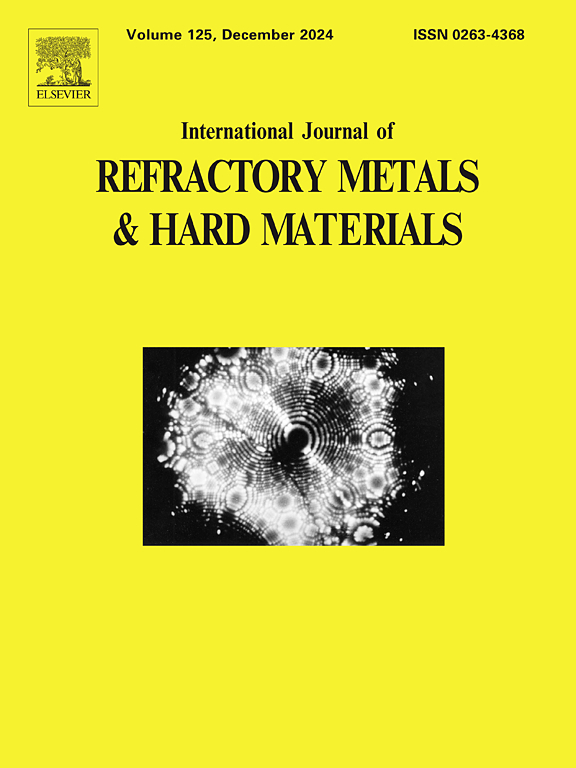Improved high temperature stability and enhanced high-speed dry cutting performance of AlCrBN coatings by alloying with B
IF 4.2
2区 材料科学
Q2 MATERIALS SCIENCE, MULTIDISCIPLINARY
International Journal of Refractory Metals & Hard Materials
Pub Date : 2025-04-27
DOI:10.1016/j.ijrmhm.2025.107206
引用次数: 0
Abstract
Boron (B)-containing AlCrBN coatings are promising protective coatings for high-speed dry cutting application. In this work, AlCrBN coatings with various B contents (0 at.%, 2.9 at.%, and 4.8 at.% namely B0, B1, and B2) were synthesized, and their high-temperature and high-speed dry cutting performance were evaluated by the high-temperature vacuum annealing and high-speed dry cutting experiment. Comparing with B0 coating (AlCrN coating without B), B1 and B2 coatings delayed/suppressed the phase decomposition from fcc-(AlCr)N into h-AlN and Cr2N, and also suppressed the diffusion of Co from the substrate into the coating surface at an annealing temperature of 1000 °C. This also contributed to the high annealed hardness of 3400 HK0.05 at 1000 °C for B1 and B2 coatings. High-speed dry turning result showed that B1 coated insert exhibited a longer cutting time (13 min), required less cutting force, and had a lower coefficient of friction during the whole cutting process. The wear mechanisms are abrasive, adhesive, and oxidative on both rake faces and flank faces for all coated inserts, however, addition of B reduced its wear of a B1-coated insert. TEM results from the worn rake face of a B1-coated insert revealed that an oxide tribo-film composed of w-AlN and Al2O3 emerged upon the unaffected AlCrBN coating, further confirming the structural stability of the AlCrBN coating under high-speed dry cutting.

通过与B合金化,提高了AlCrBN涂层的高温稳定性和高速干切削性能
含硼AlCrBN涂层是一种很有前途的高速干切削防护涂层。在这项工作中,不同B含量的AlCrBN涂层(0 at。%, 2.9。%, 4.8%。%即B0, B1和B2),并通过高温真空退火和高速干切削实验对其高温和高速干切削性能进行了评价。与B0涂层(不含B的AlCrN涂层)相比,在1000℃退火温度下,B1和B2涂层延缓/抑制了fcc-(AlCr)N向h-AlN和Cr2N的相分解,抑制了Co从基体向涂层表面的扩散。这也使得B1和B2涂层在1000℃时退火硬度高达3400 HK0.05。高速干车削结果表明,在整个切削过程中,B1涂层刀片的切削时间更长(13 min),所需的切削力更小,摩擦系数更低。对于所有涂层刀片,前表面和后表面的磨损机制都是磨蚀性、粘附性和氧化性的,然而,添加B可以减少b1涂层刀片的磨损。TEM结果表明,在未受影响的AlCrBN涂层上出现了一层由w-AlN和Al2O3组成的氧化摩擦膜,进一步证实了AlCrBN涂层在高速干切削下的结构稳定性。
本文章由计算机程序翻译,如有差异,请以英文原文为准。
求助全文
约1分钟内获得全文
求助全文
来源期刊
CiteScore
7.00
自引率
13.90%
发文量
236
审稿时长
35 days
期刊介绍:
The International Journal of Refractory Metals and Hard Materials (IJRMHM) publishes original research articles concerned with all aspects of refractory metals and hard materials. Refractory metals are defined as metals with melting points higher than 1800 °C. These are tungsten, molybdenum, chromium, tantalum, niobium, hafnium, and rhenium, as well as many compounds and alloys based thereupon. Hard materials that are included in the scope of this journal are defined as materials with hardness values higher than 1000 kg/mm2, primarily intended for applications as manufacturing tools or wear resistant components in mechanical systems. Thus they encompass carbides, nitrides and borides of metals, and related compounds. A special focus of this journal is put on the family of hardmetals, which is also known as cemented tungsten carbide, and cermets which are based on titanium carbide and carbonitrides with or without a metal binder. Ceramics and superhard materials including diamond and cubic boron nitride may also be accepted provided the subject material is presented as hard materials as defined above.

 求助内容:
求助内容: 应助结果提醒方式:
应助结果提醒方式:


